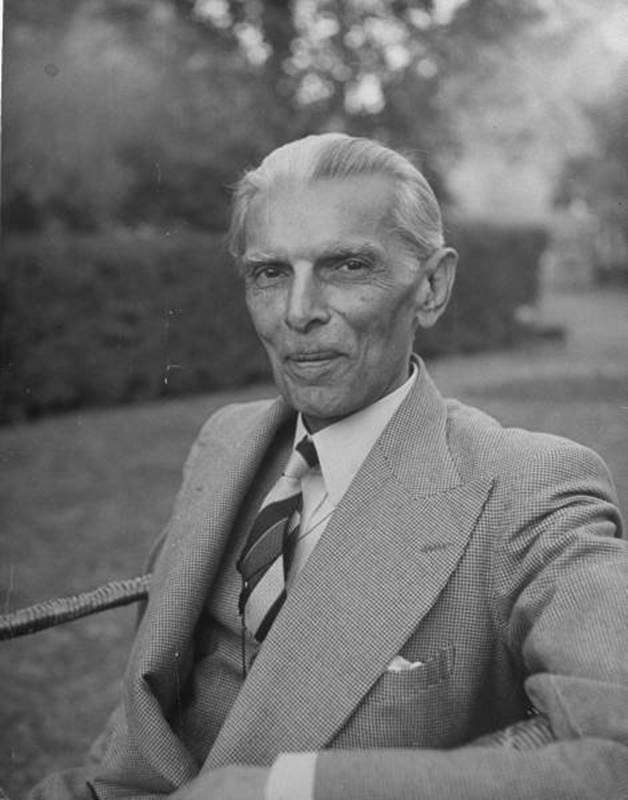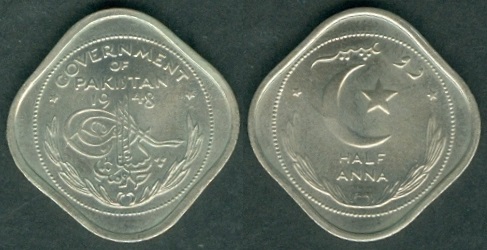 |
 |
| Pakistan Coinage: 1947 - 1948 | |||||||||||||||||||
| under Governor-General: Muhammad Ali Jinnah | |||||||||||||||||||
|
‘Few individuals significantly alter the course of
history. Fewer still modify the map of the world. Hardly anyone can be
credited with creating a nation-state. Mohammad Ali Jinnah did all three.’ -
Stanley Wolpert. Some historians like Hormasji "Homi" Maneckji Seervai and Ayesha Jalal assert that Jinnah never wanted partition of India, it was the outcome of the Congress leaders being unwilling to share power with the Muslim League. It is asserted that Jinnah only used the Pakistan demand as a method to mobilise support to obtain significant political rights for Muslims. Jinnah: India-Partition-Independence is a book written by Jaswant Singh, former Finance Minister of India, on Pakistan's founder Muhammad Ali Jinnah and the politics associated with the partition of British India. It contains controversial opinions of Singh, praising Jinnah for standing up to the Indian National Congress and the British. He claimed that Pandit Jawaharlal Nehru's centralized polity was responsible for partition, and that Jinnah was portrayed as a demon by India for the partition. |
 |
||||||||||||||||||
| Government of Pakistan on Friday 15th Aug 1947 in a glance: This is the most important day in the history of Pakistan: today it is born! Yesterday, the last British viceroy Lord Mountbatten read the King's message to the Constituent Assembly of Pakistan and left for New Delhi. Jinnah (who is officially called Quaid-i-Azam since Tuesday), refused to accept the suggestion of some sycophants that since the Viceroy had left the Pakistani soil, Pakistan should haul down the Union Jack before sunset. That, according to Mr. Jinnah, would be disorderly. Hence, the Radio went on announcing itself as "All India Radio" until late night yesterday, and only declared the birth of Pakistan at midnight. The official celebrations were put up till this morning, unlike in India. There, the PM Nehru made his inaugural speech a little before midnight: "Long ago we made a tryst with destiny, and now the time comes when we shall redeem our pledge... At the stroke of the midnight hour, when the world sleeps, India will wake to life and freedom." The "stroke of the midnight hour" was selected by the Indian Government because 15 August has been declared inauspicious by the astrologers, hence the Congress wanted India to be born at least before the sunrise. | |||||||||||||||||||
| Mr. Jinnah, since he does not give way to astrological predictions, made a point not to start official celebrations until after a proper breakfast this morning. Then he and his cabinet were sworn in, along with the provincial governors. Later, he hoisted the national flag, and made a broadcast to the nation: "August 15 is the birthday of the independent and sovereign state of Pakistan. It marks the fulfillment of the destiny of the Muslim nation which made great sacrifices in the past few years to have its homeland." He also declared: "Our object should be peace within and peace without... We stand by the United Nations Charter and will gladly make our full contribution to the peace and prosperity of the world." | |||||||||||||||||||
|
His Majesty,
George VI, is technically the constitutional monarch of both the new
dominions, India and Pakistan, which will be equal members of the
Commonwealth of Nations. The Indian Independence Bill, which created the two
dominions, empowers the Constituent Assemblies of the dominions to make all
legislation, including a decision to leave the Commonwealth or declare
republics. Mr. Jinnah, working more out of pragmatism than sentiments, has
requested many competent British to stay: 3 out of the 4 governors are
white. They are: Sir Frederick Bourne (Governor, East Bengal), Sir Francis
Mudie (Governor, West Punjab), and Sir George Cunningham (Governor, N.W.F.P.).
Sir Ghulam Hussain Hidayatullah (Governor, Sindh) is the only native
governor, while Baluchistan does not have a governor as it is a
Governor-General's province. All chiefs of the armed forces are white too:
General Sir Frank Messervey (Royal Pakistan Army), Air Vice-Marshal
Perry-Keane (Royal Pakistan Air Force), and Admiral Jefford (Royal Pakistan
Navy). The financial advisor to the Governor-General, Sir Archibald Rowland,
is also a British. The first cabinet of Pakistan, sworn in today, includes: Liaquat Ali Khan (Prime Minister, also in charge of two ministries: Foreign Affairs & Commonwealth Relations, and Defense); Ibrahim Ismail Chundrigar (Commerce, Industries, and Works); Ghulam Mohammad (Finance); Abdur Rab Nishtar (Communications); Ghazanfar Ali Khan (Food, Agriculture, and Health); Jogendra Nath Mandal (Law and Labour); Fazlur Rahman (Interior, Information, and Education). |
|||||||||||||||||||
| Khawaja Nazimuddin has been elected the Chief Minister of East Bengal by the provincial assembly (Suhrawardy, who was the Chief Minister, has gone to India on Gandhi's invitation to work for communal harmony). The Khan of Mamdot has been elected the Chief Minister of West Punjab, while the NWFP still has the ministry of Dr. Khan Sahib in place. Sind already had a Muslim League ministry, and Mohammad Ayub Khuhro remains the Chief Minister. | |||||||||||||||||||
| The nawab of Bahawalpur has assumed the title Jalalatul Mulk Ala Hazrat Amir of Bahawalpur. Although he has agreed to send his representative to the Constituent Assembly of Pakistan, it is rumored that he and his chief minister, Mushtaq Ahmed Gurmani are inclined towards stalling the issue of accession to Pakistan. Bahawalpur happens to be the largest of the ten Muslim majority states that are contiguous to Pakistan. The others are: Khairpur, Kalat, Las Bela, Kharan, Mekran, and the four frontier states of Dir, Swat, Amb, and Chitral. On the other hand, all (except two) of the 500 odd Hindu majority states as well as the Muslim majority state Kapurthala have acceded to India. | |||||||||||||||||||
| Attacks on trains by Sikhs in East Punjab forces the Government of Pakistan to postpone the transfer of records from New Delhi to Karachi until the situation comes to normal. In the afternoon, a Sikh mob paraded a number of Muslim women naked through the streets of Amritsar, raped them and then hacked some of them to pieces with kirpans and burned the others alive. Many have lost their homes, witnessed brutal slaughters of their dear ones and ravishing of their nearest women. Just some of them are lucky enough to have still made it to Pakistan from the areas torn with communal riots - mostly East Punjab, but generally the whole of the sub-continent. Who is to blame? Some mention the last viceroy, Lord Mountbatten, whose role is becoming somewhat more shady as more of his plans about the division of Punjab and Bengal are materializing. Speaking to two Indian journalists in New Delhi on the 27th August, Lord Mountbatten admitted that he was aware of the Sikh plans for ethnic cleansing of the East Punjab long before the partition. He had tried to argue with them, he says, but they were adamant, and the situation is now "out of anybody's control." Will the refugees ever be able to rehabilitate, in whatever manner? This is one of the biggest questions facing the newborn state. | |||||||||||||||||||
| Next day, Liaquat Ali Khan is in Delhi to discuss the grim situation in Punjab, and Chaudhri Muhammad Ali are handed Radcliffe's reports by Mountbatten in the afternoon. [Radcliffe signed his reports on 12th August for the Punjab and Bengal, forming the Award. Ferozepur, Zira, Gurdaspur and many other areas of Muslim majority in East Punjab form parts of India, and so does the city of Calcutta. Report is withheld until after the Independence. Radcliffe signs his reports for Sylhet on 13th August.] | |||||||||||||||||||
| Pakistan does not have a single ordinance factory and the remark can almost be stretched to include major installations of every sort. Although Pakistan has inherited 20 per cent of the subcontinent's population, her share in industry is less than 7 per cent, consisting mostly of small-scale and minor industrial units: the 34 factories do not total up to a daily employment of more than 26, 400 persons. The East wing produces 70 per cent of the world's jute, but there is not a single jute mill and the West Bengal (now in India) is almost the sole buyer. In the West wing, only 16000 of the total 1500000 cotton bales produced can be processed domestically. The new state does not have its own bank and depends on the reserve bank of India. | |||||||||||||||||||
| The radio stations of the newly born state are located at Peshawar, Lahore and Dacca but none in the federal capital Karachi. Out of these, Peshawar station boasts a broadcasting transmitter assembled and donated by the inventor Marconi himself. | |||||||||||||||||||
| Currency: Rupee = 16 Anna = 64 Pice = 192 Pie | |||||||||||||||||||
| 1947 | |||||||||||||||||||
| The coins were two of a total six pairs of pattern Rupee prepared in 1947 prior to the commencement of coinage for the newly independent Republic of Pakistan. Neither of the designs was adopted and when Sinclair-Jones (Mint Master at Lahore) left Pakistan during the turmoil of the 1947-1948 riots, the four sets were lost and their present whereabouts is unknown. A pair of pattern Rupee dated 1947 were struck in nickel. | |||||||||||||||||||
| 01. Obverse: Crescent and star, value in Urdu above and in English below. Dates to the left and right. Reverse: Toughra within circle, "Government of Pakistan" written in the outer circle. It had a milled edge. | |||||||||||||||||||
| 02. Another pair of nickel pattern Rupee dated 1947 were also struck with slightly different design. Obverse: It had dates with "Government of Pakistan" legend written in the outer circle and Toughra within the inner circle. Reverse: Crescent and star, value in Urdu above and in English below with smaller stars on both left and right sides. It had a milled edge. | |||||||||||||||||||
| 03. According to Spinks, a nickel pattern Rupee dated 1947 as per adopted design of 1948 exists. It is possibly the only known specimen. | |||||||||||||||||||
| 1948 | |||||||||||||||||||
| The Toughra on Pakistan coin states in Urdu; Hukumat-e-Pakistan [Government of Pakistan], used from 1947 to 1974. | |||||||||||||||||||
|
|||||||||||||||||||
|
|||||||||||||||||||
|
Speech on the occasion of the opening of the State
Bank of Pakistan by Muhammad Ali Jinnah on 1st July, 1948: "Mr. Governor, Directors of the State Bank, Ladies and Gentlemen The opening of the State Bank of Pakistan symbolises the sovereignty of our State in the financial sphere and I am very glad to be here today to perform the opening ceremony. It was not considered feasible to start a bank of our own simultaneously with the coming into being of Pakistan in August last year. A good deal of preparatory work must precede the inauguration of an institution responsible for such technical and delicate work as note issue and banking. To allow for this preparation, it was provided, under the Pakistan Monetary System and Reserve Bank Order, 1947, that the Reserve Bank of India should continue to be the currency and banking authority in Pakistan till the 30th September, 1948. Later on it was felt that it would be in that best interest of our State if the Reserve Bank of India were relieved of its functions in Pakistan, as early as possible. The date of transfer of these functions to a Pakistan agency was consequently advanced by three months in agreement with the Government of India and the Reserve Bank. ....." |
|||||||||||||||||||
|
|
|||||||||||||||||||
| Photo: Muhammad Ali Jinnah holding a proof 1948 coin set of Pakistan. | |||||||||||||||||||
Early coins used:
Early coins of small dynasties and Indian Princely states joining Pakistan:
View coins issued during the Governor-General and Presidential rulers of Pakistan:
Other Pakistan related Numismatic Items: |
|||||||||||||||||||
| Pakistan | |||||||||||||||||||
| Countries / Territories | |||||||||||||||||||
| Chiefa Coins | |||||||||||||||||||







